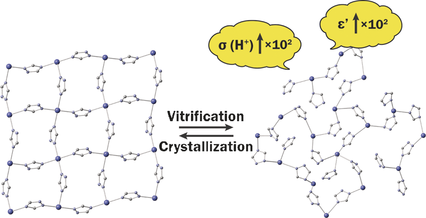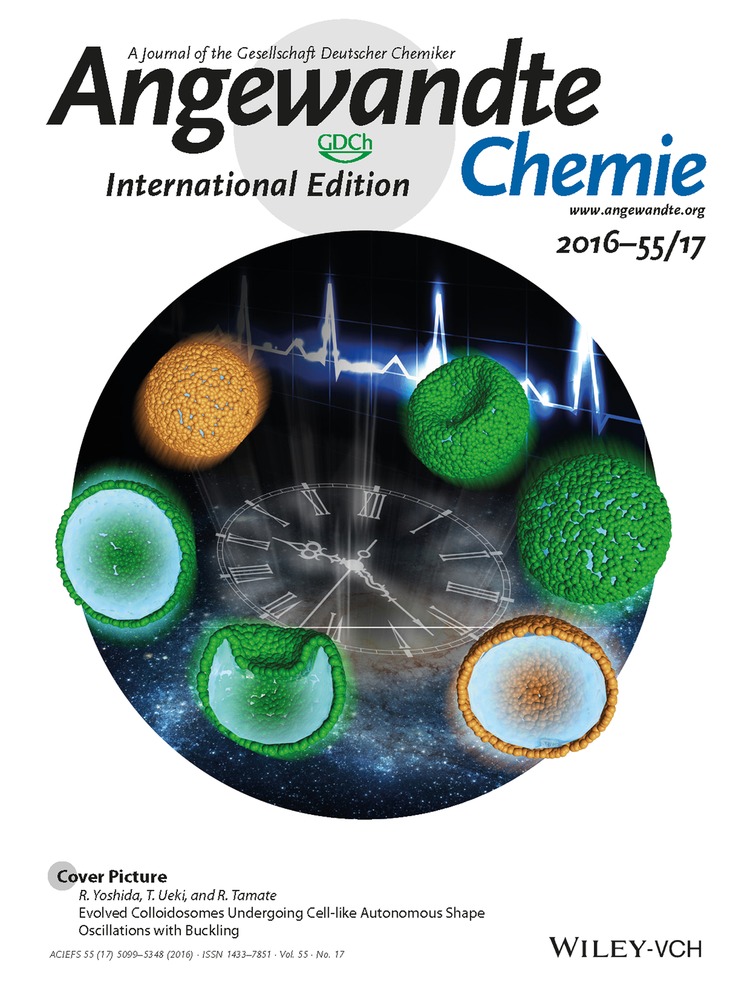Glass Formation of a Coordination Polymer Crystal for Enhanced Proton Conductivity and Material Flexibility
Dr. Wenqian Chen
Department of Synthetic Chemistry and Biological Chemistry, Graduate School of Engineering, Kyoto University, Katsura, Nishikyo-ku, Kyoto, 615–8510 Japan
Search for more papers by this authorCorresponding Author
Dr. Satoshi Horike
Department of Synthetic Chemistry and Biological Chemistry, Graduate School of Engineering, Kyoto University, Katsura, Nishikyo-ku, Kyoto, 615–8510 Japan
Search for more papers by this authorDr. Daiki Umeyama
Department of Synthetic Chemistry and Biological Chemistry, Graduate School of Engineering, Kyoto University, Katsura, Nishikyo-ku, Kyoto, 615–8510 Japan
Search for more papers by this authorNaoki Ogiwara
Department of Synthetic Chemistry and Biological Chemistry, Graduate School of Engineering, Kyoto University, Katsura, Nishikyo-ku, Kyoto, 615–8510 Japan
Search for more papers by this authorTomoya Itakura
DENSO CORPORATION, 1-1 Showa-cho, Kariya, Aichi, 448–8661 Japan
Search for more papers by this authorDr. Cédric Tassel
Department of Energy and Hydrocarbon Chemistry, Graduate School of Engineering, Kyoto University, Katsura, Nishikyo-ku, Kyoto, 615–8510 Japan
Search for more papers by this authorYoshihiro Goto
Department of Energy and Hydrocarbon Chemistry, Graduate School of Engineering, Kyoto University, Katsura, Nishikyo-ku, Kyoto, 615–8510 Japan
Search for more papers by this authorProf. Hiroshi Kageyama
Department of Energy and Hydrocarbon Chemistry, Graduate School of Engineering, Kyoto University, Katsura, Nishikyo-ku, Kyoto, 615–8510 Japan
Search for more papers by this authorCorresponding Author
Prof. Susumu Kitagawa
Department of Synthetic Chemistry and Biological Chemistry, Graduate School of Engineering, Kyoto University, Katsura, Nishikyo-ku, Kyoto, 615–8510 Japan
Institute for Integrated Cell-Material Sciences (WPI-iCeMS), Kyoto University, Yoshida, Sakyo-ku, Kyoto, 606–8501 Japan
Search for more papers by this authorDr. Wenqian Chen
Department of Synthetic Chemistry and Biological Chemistry, Graduate School of Engineering, Kyoto University, Katsura, Nishikyo-ku, Kyoto, 615–8510 Japan
Search for more papers by this authorCorresponding Author
Dr. Satoshi Horike
Department of Synthetic Chemistry and Biological Chemistry, Graduate School of Engineering, Kyoto University, Katsura, Nishikyo-ku, Kyoto, 615–8510 Japan
Search for more papers by this authorDr. Daiki Umeyama
Department of Synthetic Chemistry and Biological Chemistry, Graduate School of Engineering, Kyoto University, Katsura, Nishikyo-ku, Kyoto, 615–8510 Japan
Search for more papers by this authorNaoki Ogiwara
Department of Synthetic Chemistry and Biological Chemistry, Graduate School of Engineering, Kyoto University, Katsura, Nishikyo-ku, Kyoto, 615–8510 Japan
Search for more papers by this authorTomoya Itakura
DENSO CORPORATION, 1-1 Showa-cho, Kariya, Aichi, 448–8661 Japan
Search for more papers by this authorDr. Cédric Tassel
Department of Energy and Hydrocarbon Chemistry, Graduate School of Engineering, Kyoto University, Katsura, Nishikyo-ku, Kyoto, 615–8510 Japan
Search for more papers by this authorYoshihiro Goto
Department of Energy and Hydrocarbon Chemistry, Graduate School of Engineering, Kyoto University, Katsura, Nishikyo-ku, Kyoto, 615–8510 Japan
Search for more papers by this authorProf. Hiroshi Kageyama
Department of Energy and Hydrocarbon Chemistry, Graduate School of Engineering, Kyoto University, Katsura, Nishikyo-ku, Kyoto, 615–8510 Japan
Search for more papers by this authorCorresponding Author
Prof. Susumu Kitagawa
Department of Synthetic Chemistry and Biological Chemistry, Graduate School of Engineering, Kyoto University, Katsura, Nishikyo-ku, Kyoto, 615–8510 Japan
Institute for Integrated Cell-Material Sciences (WPI-iCeMS), Kyoto University, Yoshida, Sakyo-ku, Kyoto, 606–8501 Japan
Search for more papers by this authorGraphical Abstract
Abstract
The glassy state of a two-dimensional (2D) Cd2+ coordination polymer crystal was prepared by a solvent-free mechanical milling process. The glassy state retains the 2D structure of the crystalline material, albeit with significant distortion, as characterized by synchrotron X-ray analyses and solid-state multinuclear NMR spectroscopy. It transforms to its original crystal structure upon heating. Thus, reversible crystal-to-glass transformation is possible using our new processes. The glass state displays superior properties compared to the crystalline state; specifically, it shows anhydrous proton conductivity and a dielectric constant two orders of magnitude greater than the crystalline material. It also shows material flexibility and transparency.
Supporting Information
As a service to our authors and readers, this journal provides supporting information supplied by the authors. Such materials are peer reviewed and may be re-organized for online delivery, but are not copy-edited or typeset. Technical support issues arising from supporting information (other than missing files) should be addressed to the authors.
| Filename | Description |
|---|---|
| anie201600123-sup-0001-misc_information.pdf1.4 MB | Supplementary |
Please note: The publisher is not responsible for the content or functionality of any supporting information supplied by the authors. Any queries (other than missing content) should be directed to the corresponding author for the article.
References
- 1
- 1aS. R. Batten, R. Robson, Angew. Chem. Int. Ed. 1998, 37, 1460–1494;
10.1002/(SICI)1521-3773(19980619)37:11<1460::AID-ANIE1460>3.0.CO;2-Z CAS PubMed Web of Science® Google ScholarAngew. Chem. 1998, 110, 1558–1595;10.1002/(SICI)1521-3757(19980605)110:11<1558::AID-ANGE1558>3.0.CO;2-7 Web of Science® Google Scholar
- 1bM. Eddaoudi, D. B. Moler, H. Li, B. Chen, T. M. Reineke, M. O'Keeffe, O. M. Yaghi, Acc. Chem. Res. 2001, 34, 319–330;
- 1cB. Moulton, M. J. Zaworotko, Chem. Rev. 2001, 101, 1629–1658;
- 1dS. Kitagawa, R. Kitaura, S. Noro, Angew. Chem. Int. Ed. 2004, 43, 2334–2375; Angew. Chem. 2004, 116, 2388–2430;
- 1eJ. Lee, O. K. Farha, J. Roberts, K. A. Scheidt, S. T. Nguyen, J. T. Hupp, Chem. Soc. Rev. 2009, 38, 1450–1459;
- 1fD. F. Weng, Z. M. Wang, S. Gao, Chem. Soc. Rev. 2011, 40, 3157–3181;
- 1gG. Givaja, P. Amo-Ochoa, C. J. Gomez-Garcia, F. Zamora, Chem. Soc. Rev. 2012, 41, 115–147.
- 2S. R. Batten, N. R. Champness, X.-M. Chen, J. Garcia-Martinez, S. Kitagawa, L. Öhrström, M. O'Keeffe, M. Paik Suh, J. Reedijk, Pure Appl. Chem. 2013, 85, 1715–1724.
- 3
- 3aZ. Sun, T. Chen, J. Luo, M. Hong, Angew. Chem. Int. Ed. 2012, 51, 3871–3876; Angew. Chem. 2012, 124, 3937–3942;
- 3bH. Wu, Y. S. Chua, V. Krungleviciute, M. Tyagi, P. Chen, T. Yildirim, W. Zhou, J. Am. Chem. Soc. 2013, 135, 10525–10532;
- 3cR. Ameloot, F. Vermoortele, J. Hofkens, F. C. De Schryver, D. E. De Vos, M. B. Roeffaers, Angew. Chem. Int. Ed. 2013, 52, 401–405; Angew. Chem. 2013, 125, 419–423;
- 3dM. J. Cliffe, W. Wan, X. Zou, P. A. Chater, A. K. Kleppe, M. G. Tucker, H. Wilhelm, N. P. Funnell, F. X. Coudert, A. L. Goodwin, Nat. Commun. 2014, 5, 4176;
- 3eJ. M. Taylor, S. Dekura, R. Ikeda, H. Kitagawa, Chem. Mater. 2015, 27, 2286–2289.
- 4
- 4aH. Deng, C. J. Doonan, H. Furukawa, R. B. Ferreira, J. Towne, C. B. Knobler, B. Wang, O. M. Yaghi, Science 2010, 327, 846–850;
- 4bT. Fukushima, S. Horike, Y. Inubushi, K. Nakagawa, Y. Kubota, M. Takata, S. Kitagawa, Angew. Chem. Int. Ed. 2010, 49, 4820–4824; Angew. Chem. 2010, 122, 4930–4934;
- 4cA. D. Burrows, CrystEngComm 2011, 13, 3623.
- 5
- 5aR. P. Swatloski, S. K. Spear, J. D. Holbrey, R. D. Rogers, J. Am. Chem. Soc. 2002, 124, 4974–4975;
- 5bK. W. Chapman, G. J. Halder, P. J. Chupas, J. Am. Chem. Soc. 2009, 131, 17546–17547;
- 5cK. Ohara, J. Marti-Rujas, T. Haneda, M. Kawano, D. Hashizume, F. Izumi, M. Fujita, J. Am. Chem. Soc. 2009, 131, 3860–3861;
- 5dT. D. Bennett, A. L. Goodwin, M. T. Dove, D. A. Keen, M. G. Tucker, E. R. Barney, A. K. Soper, E. G. Bithell, J. C. Tan, A. K. Cheetham, Phys. Rev. Lett. 2010, 104, 115503.
- 6
- 6aP. G. Debenedetti, F. H. Stillinger, Nature 2001, 410, 259–267;
- 6bK. J. Rao, Structural Chemistry of Glasses, Elsevier, Amsterdam, 2002;
- 6cI. Sestak, W. Distler, J. F. Forbes, M. Dowsett, A. Howell, J. Cuzick, J. Clin. Oncol. 2010, 28, 3411–3415.
- 7T. D. Bennett, J. C. Tan, Y. Yue, E. Baxter, C. Ducati, N. J. Terrill, H. H. Yeung, Z. Zhou, W. Chen, S. Henke, A. K. Cheetham, G. N. Greaves, Nat. Commun. 2015, 6, 8079.
- 8
- 8aS. Horike, D. Umeyama, M. Inukai, T. Itakura, S. Kitagawa, J. Am. Chem. Soc. 2012, 134, 7612–7615;
- 8bD. Umeyama, S. Horike, M. Inukai, T. Itakura, S. Kitagawa, J. Am. Chem. Soc. 2015, 137, 864–870.
- 9D. Umeyama, S. Horike, M. Inukai, T. Itakura, S. Kitagawa, J. Am. Chem. Soc. 2012, 134, 12780–12785.
- 10
- 10aJ. C. Rybak, M. Hailmann, P. R. Matthes, A. Zurawski, J. Nitsch, A. Steffen, J. G. Heck, C. Feldmann, S. Gotzendorfer, J. Meinhardt, G. Sextl, H. Kohlmann, S. J. Sedlmaier, W. Schnick, K. Müller-Buschbaum, J. Am. Chem. Soc. 2013, 135, 6896–6902;
- 10bG. Lorusso, J. W. Sharples, E. Palacios, O. Roubeau, E. K. Brechin, R. Sessoli, A. Rossin, F. Tuna, E. J. McInnes, D. Collison, M. Evangelisti, Adv. Mater. 2013, 25, 4653–4656;
- 10cS. Tominaka, F. X. Coudert, T. D. Dao, T. Nagao, A. K. Cheetham, J. Am. Chem. Soc. 2015, 137, 6428–6431.
- 11
- 11aY. H. Hu, L. Zhang, Phys. Rev. B 2010, 81, 1741031–1741035;
- 11bS. Cao, T. D. Bennett, D. A. Keen, A. L. Goodwin, A. K. Cheetham, Chem. Commun. 2012, 48, 7805–7807;
- 11cM. Zhou, K. Wang, Z. Men, C. Sun, Z. Li, B. Liu, G. Zou, B. Zou, CrystEngComm 2014, 16, 4084.
- 12
- 12aK. Suzuki, J. Non-Cryst. Solids 1989, 112, 23–32;
- 12bH. J. Fecht, G. Han, Z. Fu, W. L. Johnson, J. Appl. Phys. 1990, 67, 1744–1748;
- 12cJ. Font, J. Muntasell, E. Cesari, Mater. Res. Bull. 1997, 32, 1691–1696;
- 12dM. Nagahama, H. Suga, O. Andersson, Thermochim. Acta 2000, 363, 165–174;
- 12eJ. F. Willart, A. De Gusseme, S. Hemon, G. Odou, F. Danede, M. Descamps, Solid State Commun. 2001, 119, 501–505;
- 12fL. C. Zhang, J. Xu, Mater. Lett. 2002, 56, 615–619;
- 12gJ. F. Willart, L. Carpentier, F. Danede, M. Descamps, J. Pharm. Sci. 2012, 101, 1570–1577.
- 13H. J. Fecht, E. Hellstern, Z. Fu, W. L. Johnson, Metall. Trans. A 1990, 21, 2333–2337.
- 14
- 14aE. A. R. Duek, C. A. C. Zavaglia, W. D. Belangero, Polymer 1999, 40, 6465–6473;
- 14bL.-M. Wang, G. Li, Z. J. Zhan, L. L. Sun, W. K. Wang, Philos. Mag. Lett. 2001, 81, 419–423.
- 15
- 15aS. J. Billinge, M. G. Kanatzidis, Chem. Commun. 2004, 749–760;
- 15bR. B. Neder, V. I. Korsunskiy, J. Phys. Condens. Matter 2005, 17, S 125–S134;
- 15cP. K. Allan, K. W. Chapman, P. J. Chupas, J. A. Hriljac, C. L. Renouf, T. C. A. Lucas, R. E. Morris, Chem. Sci. 2012, 3, 2559.
- 16G. N. Greaves, S. Sen, Adv. Phys. 2007, 56, 1–166.
- 17
- 17aM. F. Summers, Coord. Chem. Rev. 1988, 86, 43–134;
- 17bA. V. Kuttatheyil, M. Handke, J. Bergmann, D. Lassig, J. Lincke, J. Haase, M. Bertmer, H. Krautscheid, Chem. Eur. J. 2015, 21, 1118–1124.
- 18S. Hayashi, K. Hayamizu, Bull. Chem. Soc. Jpn. 1989, 62, 3061–3068.
- 19A. B. Cairns, A. L. Goodwin, Chem. Soc. Rev. 2013, 42, 4881–4893.
- 20
- 20aT. Minami, J. Non-Cryst. Solids 1985, 73, 273–284;
- 20bK. R. Seddon, J. Chem. Technol. Biotechnol. 1997, 68, 351–356;
- 20cA. Hayashi, K. Noi, A. Sakuda, M. Tatsumisago, Nat. Commun. 2012, 3, 856.
- 21K. D. Kreuer, S. Adams, W. Munch, A. Fuchs, U. Klock, J. Maier, Solid State Ionics 2001, 145, 295–306.
- 22
- 22aN. B. Desai, K. Byrappa, G. S. Gopalakrishna, S. Srikantaswamy, A. B. Kulkarni, Bull. Mater. Sci. 1987, 9, 317–321;
- 22bP. Colomban, A. Novak, J. Mol. Struct. 1988, 177, 277–308;
- 22cM. G. Bellino, D. G. Lamas, N. Walsöe de Reca, Adv. Funct. Mater. 2006, 16, 107–113;
- 22dM. Schuster, K. D. Kreuer, H. Steininger, J. Maier, Solid State Ionics 2008, 179, 523–528.
- 23J.-M. Le Meins, O. Bohnke, G. Courbion, Solid State Ionics 1998, 111, 67–75.
- 24A. Zheng, S. J. Huang, S. B. Liu, F. Deng, Phys. Chem. Chem. Phys. 2011, 13, 14889–14901.
- 25
- 25aD. Braga, S. L. Giaffreda, F. Grepioni, A. Pettersen, L. Maini, M. Curzi, M. Polito, Dalton Trans. 2006, 1249–1263;
- 25bA. L. Garay, A. Pichon, S. L. James, Chem. Soc. Rev. 2007, 36, 846–855;
- 25cP. J. Beldon, L. Fabian, R. S. Stein, A. Thirumurugan, A. K. Cheetham, T. Friščić, Angew. Chem. Int. Ed. 2010, 49, 9640–9643; Angew. Chem. 2010, 122, 9834–9837.





